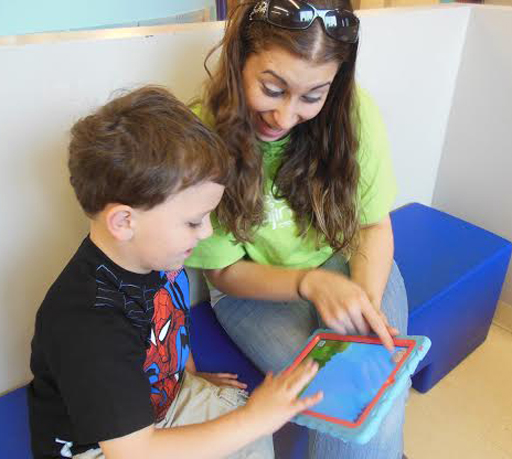The Harvard Family Research Project separated from the Harvard Graduate School of Education to become the Global Family Research Project as of January 1, 2017. It is no longer affiliated with Harvard University.

|
June 9, 2014 Q & A With Susan Leger Ferraro and Fran Hurley: Learning Through Technology-Infused PlayHarvard Family Research Project
|
FINE Newsletter, Volume VI, Issue 3
Issue Topic: Expanding Opportunity: The Potential of Anywhere, Anytime Learning
Voices From the Field
Research-practice partners Susan Leger Ferraro and Fran Hurley join us for an exciting Q & A about an innovative museum and play space, Imajine That.
|
Could you explain the concept of anywhere, anytime learning? |
|
To us, this concept has to do with the real possibility of rich, deep learning in all aspects of life, not just within the traditional school environment. This concept goes hand in hand with an ecological view of childhood, in which the developing child is viewed within the broad context of the family and the neighborhood, including, for example, the school system and cultural institutions. Access to quality technological experiences is a part of anywhere, anytime learning. |
|
|
Why is this anywhere, anytime learning concept important in early childhood? |
|
|
As is well established, early childhood is an important time for a child’s developing brain. As such, we need every child to experience the wonder of playful learning within a wide network of learning opportunities. |
|
|
What did you learn from the creation of your early childhood centers? |
|
|
We learned so much. With respect to ensuring a quality, developmentally appropriate learning experience for our children, there were three main points. First, we learned that leadership has to have a strong vision of what the final “product” should look like. An important question to ask is: How are the teachers interacting with the children, and what are the results? Second, a strong evaluation team is crucial. A skilled evaluation team can help leadership truly understand teacher and child outcomes and use the information for continuous improvement, including the provision of relevant, timely professional development for teachers. This was our third critical lesson: Great teacher professional development is key to ensuring better teacher and student outcomes; it also brings everyone closer to realizing the vision of effective anywhere, anytime learning. Successful professional development programs must include one-on-one development activities that focus not only on student outcomes but also on the whole teacher and the teacher’s quality of life. |
|
| How has what you learned influenced your approach to providing children anywhere, anytime learning opportunities today? | |
| Today, as we ponder the many ways we can expand our thinking to include anywhere, anytime learning for preschool children, we always come back to the importance of quality, developmentally appropriate experiences. We know what these can look like in a traditional early childhood classroom. Now, we must imagine what these experiences might look like in new settings. | |
| Can you give an example of a new setting? | |
| Yes. In 2005, we developed the Imajine That Museum and Educational Play Space as a place for families to bring their children to play, socialize, and learn together as a family. Located in Lawrence, Massachusetts, our unique 12,000-square-foot play space offers an environment where families can create and learn together in an innovative and educational manner. Central to visitors’ learning experiences are Imajine That’s Imagination Exhibits, which were created through strategic partnerships. For example, these play spaces include a child-sized Whole Foods® grocery store and a related food-making workspace; a huge custom-designed dinosaur climbing structure that features 108 gross-motor action spots; a Between the Lions® literacy area; a Peep and the Big Wide World® science station; a Lowell General Hospital Doctors Office play area; and our Create and Learn Arts and Exploration Area, just to name a few. Families who visit our museum typically come from within a 30-mile radius of Lawrence, and our staff members engage with more than 17,000 parents and children annually. | |
| How does technology play a role in this space? | |
| Technology is infused into this space in a number of ways. For example, during our pizza-making workshops, we use a SMART Board to show the children aspects of the pizza-making process. We provide iPads that children and parents can use to play selected educational games in the literacy and science areas. We also offer parent workshops on choosing educational apps for their children. During these workshops, we use the SMART Board to show adults the apps and demonstrate their use. We have tried to base new media practices in what we know about developmentally appropriate practice. | |
 |
|
| |
How do you ensure a quality learning experience? |
| |
To ensure quality in all these experiences, we continually come back to the questions: How are the adults interacting with the children, and what are the outcomes for the children? In this environment, we are using traditional measures of quality (such as the Early Literacy and Language Classroom Observation) to understand aspects of the quality of our environment, but there is still so much more for us to think about. Traditional measures can help us understand the quality of oral interaction that takes place, for example, between an Imajinator (what we call our Early Childhood Specialists) and a child during a pizza-making workshop, but what can we tell about the quality of the oral interactions between children and parents in the workshop? Our Imajinators model best practices with respect to oral communication and positive guidance, but do we want or expect this modeling to have an impact on the parents, who are there not for explicit parenting advice but rather to learn how their child can have fun with pizza? This is the kind of question we continue to debate. |
| How do you see this work evolving over time? | |
| If phase 1 was the building of the brick-and-mortar Imajine That Museum and Educational Play Space, phase 2 is focused on building partnerships with public schools to provide afterschool services and extended learning time based on aspects of the Imajine That model. In our afterschool programs, technology-infused play-based learning is the foundation of our activities. Currently, we are partnering with two large urban school systems, including Boston Public Schools, to provide pre-K and early elementary services. We think of phase 3 as our developmental work with the Massachusetts Institute of Technology to build an Imajine That–specific educational app as well as finishing our work on the creation of a curated list of apps for parents. Finally, phase 4 is about what’s in the works, and for us, that is a digital media space for parents and children. | |
About Susan Leger Ferraro and Fran Hurley:
 Susan Leger Ferraro
|
With a practical focus on early childhood learning, educator and social entrepreneur Susan Leger Ferraro has embraced the philosophy of anywhere, anytime learning. Through the 1980s and 1990s, she established a series of award-winning early childhood education schools. Now, she is focused on creating less-traditional early childhood environments, the foundations of which are technology-infused play, and quality, as measured through developmentally appropriate practice. |
 Fran Hurley |
Over the course of her career, Fran Hurley has been a teacher, reading specialist, program evaluator, professor of education, and management consultant. She completed her doctoral degree at Harvard University in the area of human development. She has conducted award-winning research in early childhood and worked in many areas of the world, including the United States and Canada, Asia, Africa, Central America, and the Arctic. |
This resource is part of the June FINE Newsletter. The FINE Newsletter shares the newest and best family engagement research and resources from Harvard Family Research Project and other field leaders. To access the archives of past issues, please visit www.hfrp.org/FINENewsletter.
